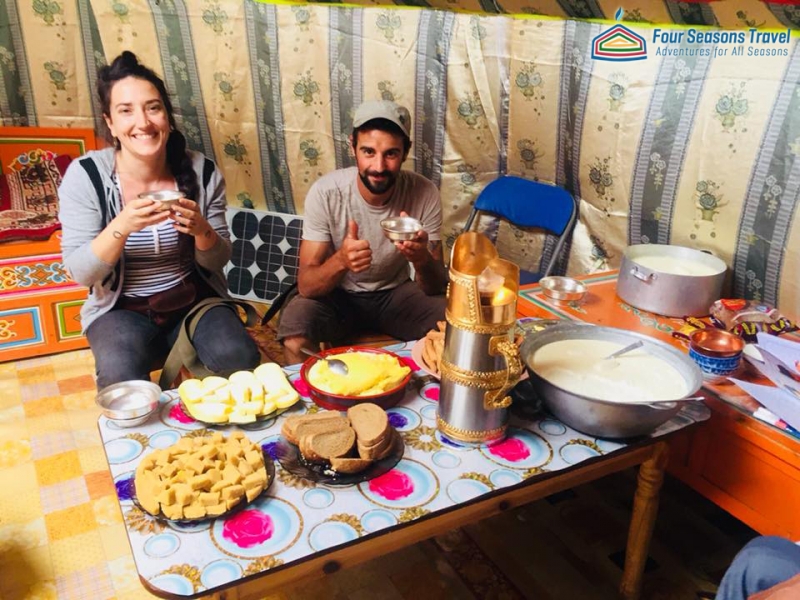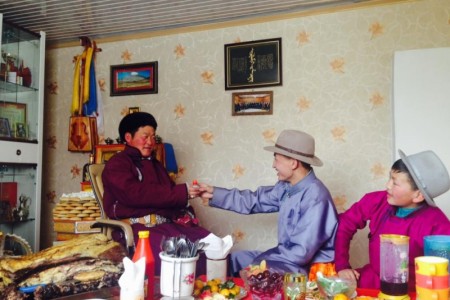Stay in Nomadic family
STAYING WITH NOMADS
If you want to know about nomadic life, staying with the hospitable nomads is a great way to experience real Mongolia at its best.
They are the friendliest people You can meet real nomads and visit their gers here. You can even stay with them for a few days to experience real nomadic culture. Our community member households welcome everyone. You can see and try dairy product making, sheep herding, mare and cow milking etc. Most of them have extra ger for their guests neighboring their ger and you will stay in their guest gers, which are roomy and comfortable. You will enjoy real nomadic delicacies and beverages and can help the nomads in their everyday work. Washing facilities are simple in nature, outhouse mainly.
Real Nomadic Lifestyle
The local nomads are fabulous! They are the friendliest people that you will ever meet. They are real, they are good and they are honest! You can meet real nomads and visit their gers here.
You can even stay with them for a few days to experience real nomadic culture. The nomads conserve the nature and take part in the tourism activities.


Mongolian traditional clothes
The Mongolian traditional costume consists of a deel, a hat, boots, and accessories. There are differences between the costumes of the various ethnic groups, but all the deels have the same shape: long sleeves, a wide flap that gets folded up on the chest, buttons on the right shoulder, a high collar, and a fabric belt around the waist.
For men, the deel for work is traditionally made of thick cotton or wool, while the women's deel is more luxurious, with silk prints. Winter deels are covered with sheep or goat skin. The traditional hat can be made of fur, silk, or felt according to its shape. The boots are generally made of leather with a thick felt lining. Many herders make their own deel and boots, and wear them, but more and more Mongolians wear occidental clothes. Nowadays, most city-wellers wear the Mongolian traditional costume only for celebrations like Tsagaan Sar (lunar new year) or for special occasions like graduation ceremony or weddings.
The first known Mongolian costume was the one that Huns wore. It consisted of a deel with a flap on front, pointed boots, and a belt. Turkish people who lived in Central Asia from the 6th to the 10th century used to wear similar clothes, but the deel was closed in the opposite direction. It's only from the 13th century that the Mongolian costume was made more beautiful, with silk instead of leather or wool. The high collar and the flap of the modern deel appeared quite recently, when Manchuria ruled on Mongolia. Beforehand, the front of the deel was closed diagonally, like Mongolian monks still wear it today.
From the beginning of the 20th century, women started to wear a sophisticated and richly decorated deel, with beautiful jewels, to show their social position. For example, the deel of a Khalkh's wife was made with silk and brocade covered with gold or silver. On top of it, she could choose to wear a uuj, or a dress without sleeves of a different colour. Regarding jewels, she used to wear pendants in coral, jade, pearls, or other precious stones, pearls being considered as the most precious material, coral and silver after. Hair were most often flattened and tied in a high veil decorated with silver. After the communist revolution, clothes so richly decorated were declared illegal because they symbolised richness. The women's dresses were made much more simple, and occidental hats and caps replaced Mongolian traditional hats. Men cut their ponytail, and women, for the first time, cut their hair too.

Customs and taboos in Mongolia
To walk or sit North of a person older than oneself. Although Mongolians believe in Confucianism with less strength than other Asian people, the elders are given considerable respect. The oldest and most respected visitors sit in the bottom of the yurt, and the other ones sit on the sides, from the oldest one to the youngest one.
To walk between the fire and the bottom of the yurt because they are the two most sacred parts of the yurt. Nomads believe that energy passes between these two points and that we must not cut it off. So the visitors must go in and go out by the same side.
To walk anti-clockwise. The “nar zuv”, literally “the good sense”, refers to clockwise. Mongolians think that everything in the universe belongs to the cycles of time and movement, so it’s important to mode in harmony with these cycles. For example, when we fold down the roof of the yurt, we must do it walking clockwise outside the yurt.
To bring weapons in the yurt. Before going in the yurt, the visitor must remove the knife from his belt and hang it in plain view to prove his friendly intentions.
Other customs rule the way guests are welcomed. Mongolians generally show great respect towards visitors and will house anyone with no preliminary appointment. When a visitor arrives, he must say “nokhoi khor!” which means, “hold your dog!” even if there’s no dog, in order to make a member of the family go out from the yurt and invite you to go in. The three main types of welcoming are tsailaga, budaalaga, and dailaga, literally “offering tea”, “offering rice”, and “offering dinner”. Tsailaga is the most frequent one: when nomads have just set up camp and want to meet their new neighbours, for example. Budaalaga and dailaga are similar but show a bigger respect for the visitor.



